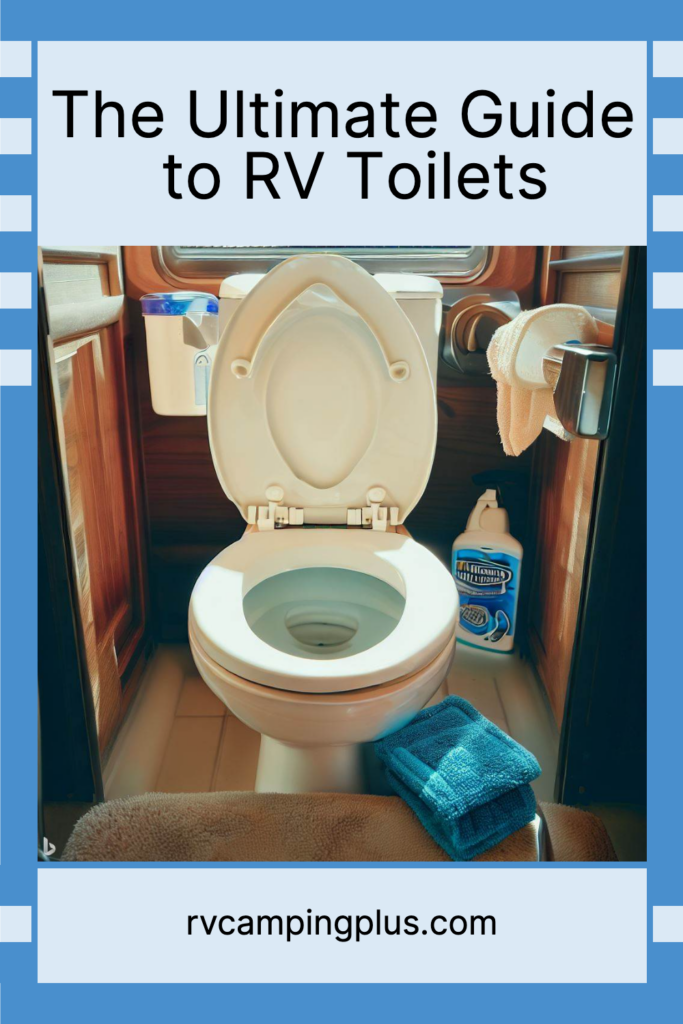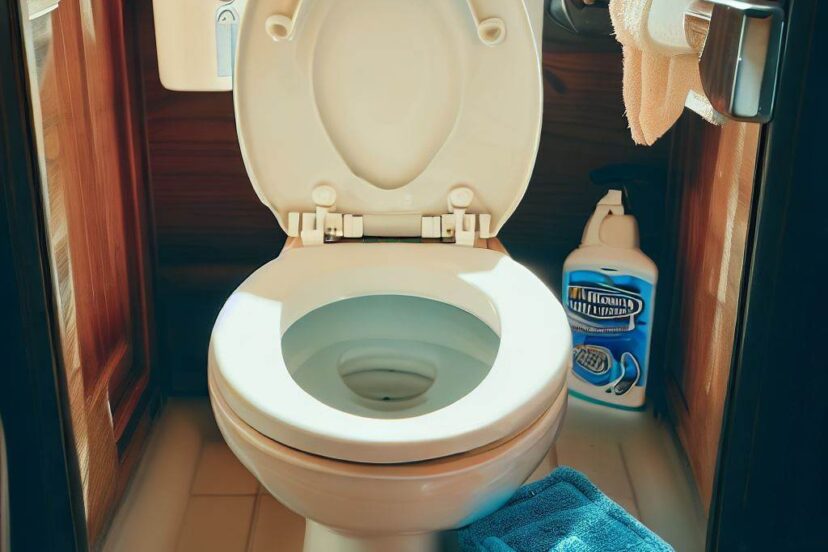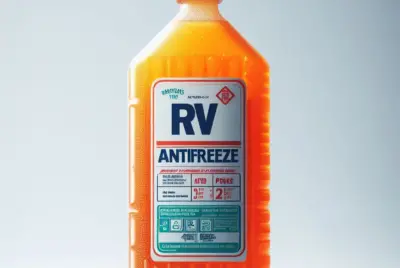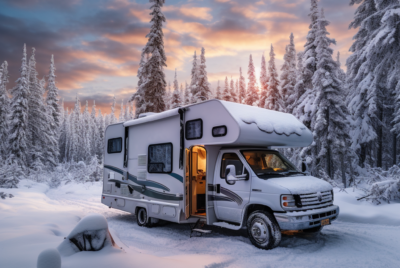The Ultimate Guide to RV Toilets: Tips for a Hassle-Free Camping Experience
As a passionate RV lifestyle and camping enthusiast, I understand the importance of having a functional and reliable toilet system in your RV. In this comprehensive article, I will address various aspects of RV toilets, covering topics such as how they work, different types available, cleaning and maintenance practices, troubleshooting common issues, eco-friendly options, and winterization techniques.
So whether you’re a seasoned RV owner looking to enhance your toilet system or a newbie in the RV camping world, this guide is here to provide valuable insights and practical suggestions. Let’s dive into the fascinating world of RV toilets and discover everything you need to know for a comfortable and hassle-free camping experience.
RV Toilet: How It Works and Tips for Optimal Performance
Understanding the Mechanism of an RV Toilet
An RV flush toilet operates differently from a traditional house flush toilet. It is specifically designed to handle waste disposal in a mobile setting. Most large RV use a traditional gravity flush toilet type, where gravity assists in moving waste through the system. When you press the flush lever, water is released into the bowl, creating a swirling motion that effectively removes waste from the bowl.
To ensure proper functioning, the gravity flush toilet is connected to a holding tank that stores the waste until it can be properly disposed of at a designated facility. The tank has a vent to prevent unpleasant odors from accumulating inside the RV.
Tips for the Best RV Toilet Performance
Proper Waste Disposal and Water Conservation
When using any portable camping toilet, being mindful of what goes down the drain is essential. Only human waste and biodegradable paper should be disposed of in the toilet bowl. Avoid flushing sanitary products, wipes, or chemicals that can damage the system or cause clogs.
Additionally, conserving water is crucial when camping in remote locations. Opt for shorter flushes and use the water-saving feature, if available, to reduce water consumption.
Regular Cleaning and Maintenance
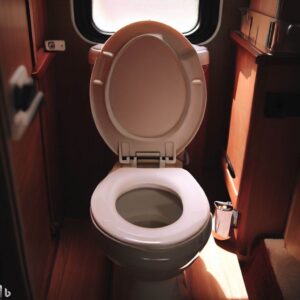 Regular maintenance is necessary to preserve your system’s performance. Use mild cleaning agents specifically designed for a plastic RV toilet to prevent damage to the seals and components. Clean the bowl, seat, and exterior of the unit regularly to keep it hygienic and fresh.
Regular maintenance is necessary to preserve your system’s performance. Use mild cleaning agents specifically designed for a plastic RV toilet to prevent damage to the seals and components. Clean the bowl, seat, and exterior of the unit regularly to keep it hygienic and fresh.
Consider Upgrading to a Water-Saving Model
Consider investing in a water-saving model if you want to upgrade to a new RV toilet. These are designed to minimize water usage without compromising on performance. Advanced flushing mechanisms and efficient water management provide a more eco-friendly option for your RV.
Understanding how a portable toilets work and implementing simple tips for optimal performance can greatly enhance your camping experience. Remember to dispose of waste responsibly, conserve water, and perform regular cleaning and maintenance. Doing so’ll ensure a reliable and hassle-free gravity toilet system throughout your adventures.
Note: This article provides general advice and suggestions. Please refer to your RV manufacturer’s guidelines and instructions for a specific domestic RV toilet for the best practices regarding your particular model.
Exploring the Different Types of RV Toilets: Finding the Perfect Fit
Choosing the best RV toilet can enhance your camping experience and provide the comfort and convenience you desire. In this article, I’ll walk you through the different types of RV toilets available in the market, helping you make an informed decision.
Traditional Gravity-Flush Toilets
The traditional gravity-flush model is the most common type. These toilets use gravity and water to remove solid waste from the bowl. When you press the flush lever, water is released into the bowl, creating a swirling motion that effectively removes waste. The waste then travels down through the plumbing into a black tank.
Gravity-flush toilets are reliable, easy to use, and require minimal maintenance. They are suitable for most RV owners who prioritize simplicity and durability.
Cassette Toilets: Portability and Convenience
Cassette toilets are another popular option for RV enthusiasts. These toilets feature a removable waste tank, making them highly portable and convenient. With a simple release mechanism, you can detach the tank and dispose of waste at a designated facility. Cassette toilets are particularly beneficial for campers who frequently boondock or camp in areas without access to dump stations.
Composting Toilets: Environmentally Friendly Choice
If you’re looking for an eco-friendly option, composting toilets are worth considering. These toilets utilize a composting medium that has a natural decomposition processes to break down waste into compost. Composting toilets work with little to no water, making them ideal for conservation-minded campers. They are also odorless when properly maintained and can be a great alternative for those seeking a more sustainable camping experience.
Choosing the right unit is essential for a comfortable and hassle-free camping adventure. Traditional gravity-flush toilets offer simplicity and reliability, while cassette toilets provide portability and convenience. For environmentally-conscious campers, these are an excellent choice.
Understanding Macerating Toilets
A macerating toilet is a type of RV toilet that utilizes a macerator pump to break down waste into a fine slurry before it is discharged into the holding tank. This technology allows for efficient waste disposal and eliminates the need for a traditional gravity-flush system. Macerating toilets are especially beneficial for RVs with limited space or unconventional plumbing configurations.
A macerating toilet requires electricity to operate the macerator pump. Ensure that your RV’s electrical system can accommodate the additional power requirements. It’s also a good idea to have a backup power source or alternative toilet option in case of power outages
The electric pump in these macerator toilets grinds waste into a fine slurry, like a garbage disposal, enabling it to flow easily through the plumbing system. This reduces the risk of clogs and ensures efficient waste disposal. Macerating toilets can handle easy disposal of waste materials that would otherwise cause issues with a regular toilet system.
Consider your camping needs, preferences, and the availability of waste disposal facilities when selecting one. By understanding the different types available, you can make an informed decision that suits your lifestyle. Happy camping!
Note: When doing any maintenance or repairs, it’s important to consult your RV manufacturer or a trusted professional for specific recommendations and installation guidance related to your RV model and toilet selection.
Keeping Your RV Toilet Clean and Well-Maintained: Best Practices for RV Camping
As a passionate RV camping enthusiast, I know that maintaining a clean and well-functioning toilet bowl is crucial for a pleasant and hassle-free camping experience. Following best practices for cleaning and maintaining your system is essential to ensure optimal performance and hygiene.
Regular Cleaning: Say Goodbye to Unwanted Odors
Cleaning your toilet regularly is key to preventing unpleasant odors and maintaining a clean environment. Start by using a mild RV-specific cleaning agent that won’t harm the toilet’s seals and components. Gently scrub the toilet’s bowl, seat, and exterior to remove any residue or stains.
Regular cleaning eliminates odors and reduces the risk of bacteria buildup, keeping your toilet area fresh and hygienic. Who wants to mess with a stinky toilet during their camping adventures?
Proper Waste Disposal: Mindful and Responsible
When it comes to waste disposal, it’s crucial to be mindful and responsible. Dispose of only human waste and biodegradable paper. Flushing sanitary products, wipes, or chemicals can damage the system or waste tank and cause clogs.
Additionally, emptying the waste tank regularly at a designated dump station or facilities is essential. Leaving waste sitting in the tank for an extended period can lead to odors and potential damage. Tank treatment in your recreational vehicle will help to avoid an uncomfortable situation so work it into your camping style.
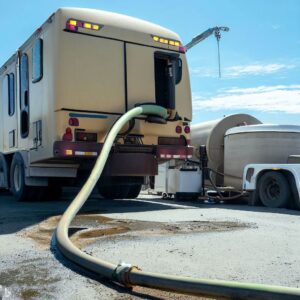
Seals and Component Maintenance: Longevity and Efficiency
Pay attention to the seals and components. Check the seals every so often for any signs of wear or damage. Replace them promptly if needed to prevent leaks and maintain a tight seal.
Furthermore, keep an eye on other components, such as the flush mechanism and water supply lines. Ensure they are functioning properly and address any issues promptly to avoid inconvenience during your camping trips.
Regular cleaning eliminates odors and promotes hygiene, while proper waste disposal and responsible use help prevent clogs and damage. Taking care of seals and components ensures the longevity and efficiency of your RV toilet.
Note: Always refer to your RV manufacturer’s guidelines and specific toilet instructions for the best practices related to your particular RV model and toilet.
Troubleshooting a Clogged RV Toilet: Tips and Tricks from an RV Camping Enthusiast
A clogged toilet can quickly turn a pleasant camping experience into a frustrating one. But fear not! Troubleshooting a clog doesn’t have to be a daunting task.
Assess the Severity: Is It a Partial or Complete Clog?
The first step in troubleshooting is to assess the severity of the clog. Is the water draining slowly or not at all? If it’s a partial clog, you may be able to resolve the issue using simple methods. However, if it’s a complete clog and the water isn’t draining at all, you may need to employ more intensive measures.
Simple Solutions for Partial Clogs
For partial clogs, start with gentle measures before resorting to more drastic actions. Begin by using a plunger specifically designed for RV toilets. Apply firm but controlled pressure to create suction and dislodge the clog. Be persistent because it might take a few attempts to clear the blockage.
Another simple solution is to use a mixture of hot water and dish soap. Pour a generous amount of hot water into the bowl, followed by a squirt of dish soap. Let your mixture stand for a couple of minutes to break down the clog, and then flush the toilet to see if it clears.
Dealing with Complete Clogs
If you’re faced with a complete clog and the previous methods haven’t resolved the issue, it’s time to take more intensive measures. One effective method is using an auger or snake. Feed it into the toilet drain and use it by rotating it to break up and remove the clog. Exercise caution to avoid damaging the toilet or waste tank and plumbing system.
You may need to consider removing the toilet from its base to gain access to the clog. This option really should be your last resort and is best left to professionals or experienced individuals.
Dealing with a clog can be a frustrating experience, but with the right troubleshooting techniques, you can quickly resolve the issue and get back to enjoying your camping adventures. Remember to assess the severity of the clog, start with simple solutions for partial clogs, and escalate to more intensive measures for complete clogs if necessary.
Note: If you encounter persistent or complex clogging issues, it’s advisable to consult a professional or seek guidance from your RV manufacturer for specific recommendations and assistance.
Exploring Eco-Friendly Options for RV Toilets: A Greener Approach to Camping
As a passionate RV camping enthusiast, I’m always on the lookout for ways to minimize my environmental impact. Finding eco-friendly options for RV toilets is one such endeavor. In this article, I’ll share my insights and helpful suggestions regarding eco-friendly options for RV toilets, allowing you to embrace a greener approach to your camping adventures.
Composting Toilet: A Sustainable Choice
Composting toilets are a popular eco-friendly option for RV owners and use a natural processes that breaks down waste into compost. By eliminating the need for water, a self contained toilet significantly reduces water consumption, making them ideal for conserving this precious resource during camping trips. They also eliminate the need for traditional RV’s black water tank and sewer hose, reducing the weight of the RV and freeing up storage space.
When operated and maintained properly, a composting toilet is virtually odorless and provides a hygienic experience. They rely on the right balance of organic material, such as sawdust or peat moss, to facilitate decomposition and neutralize any potential odors. With a composting toilet, you can enjoy a comfortable bathroom experience while minimizing your environmental footprint.
Water-Saving RV Toilets: Conservation in Action
Another eco-friendly option for RV toilets is water-saving models. These toilets are designed to minimize water usage without compromising performance. By incorporating innovative flushing mechanisms, such as dual-flush systems or low-flow technology, water-saving RV toilets can significantly reduce water consumption compared to traditional models.
Choosing a water-saving version helps conserve water during your camping trips and contributes to overall water conservation efforts. With this option, you can positively impact the environment without sacrificing comfort and functionality.
Portable Cassette Toilet: Convenience with Sustainability
A Portable cassette toilet offer a combination of convenience and sustainability. These toilets feature removable waste-holding tanks, allowing you to easily and responsibly dispose of waste at designated facilities. By utilizing cassette toilets, you can avoid the use of traditional plumbing systems and reduce water consumption, making them a practical and eco-friendly choice.
A Portable cassette toilet is particularly beneficial for boondocking or camping in areas without access to dump stations. They provide the convenience of a toilet while allowing you to minimize your environmental impact.
Embracing eco-friendly options is an excellent way to adopt a greener approach to your camping adventures. Composting toilets offer a sustainable choice with reduced water usage and effective waste management. Water-saving RV toilets help conserve water without compromising performance, and an RV cassette toilet provides convenience with responsible waste disposal.
You can enjoy your camping trips by choosing an eco-friendly option while minimizing your environmental footprint. Let’s positively impact the planet and ensure a sustainable future for all. Happy camping!
Note: It’s important to research specific eco-friendly models, consult with professionals, and adhere to local regulations and guidelines for proper installation, maintenance, and waste disposal.
Can I Use Household Chemicals in an RV Toilet? Exploring the Best Practices
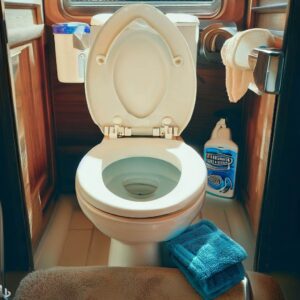 It’s essential to understand the impact of these chemicals on the system and whether they are safe to use. In this article, I’ll share my insights and provide helpful suggestions regarding the use of household chemicals, ensuring a trouble-free camping experience.
It’s essential to understand the impact of these chemicals on the system and whether they are safe to use. In this article, I’ll share my insights and provide helpful suggestions regarding the use of household chemicals, ensuring a trouble-free camping experience.
The Potential Risks: Damaging the System
Using household chemicals can pose risks to the toilet system and the environment. Many household chemicals, such as bleach, ammonia, or strong cleaning agents, can damage the seals, valves, and components. They may deteriorate the rubber seals, leading to leaks and potential water damage.
Furthermore, household chemicals can also harm the beneficial bacteria present in the tank, disrupting the natural decomposition process and potentially causing odor issues. These chemicals may not be designed for use in RV toilets, which have specific requirements and limitations due to their mobile nature.
Recommended Alternatives: RV-Specific Cleaning Products
To ensure the longevity and proper functioning, it’s best to use cleaning products specifically formulated for RV toilets. These products are designed to be compatible with the materials and components while effectively cleaning and maintaining its hygiene.
RV-specific cleaning products, such as biodegradable and septic-safe cleaners, are the ideal choice. They are formulated to clean without causing damage, maintain the necessary balance of beneficial bacteria in the tank, and minimize environmental impact.
Natural Cleaning Methods: Eco-Friendly Options
If you prefer a more eco-friendly approach and being more off-grid, natural cleaning methods can also be effective in keeping your RV clean and fresh. For example, mix vinegar and baking soda to clean the toilet bowl and remove stains.
Additionally, regular cleaning and maintenance, such as keeping the toilet bowl and exterior surfaces clean, can go a long way in preventing the need for harsh chemicals. Simple practices like emptying and cleaning the holding tank regularly help maintain a healthy and odor-free system.
Using household chemicals can have adverse effects on the toilet system and the environment. To ensure longevity and proper functioning, it’s recommended to use RV-specific cleaning products or natural cleaning methods. These alternatives effectively clean and maintain your RV toilet without causing damage or disrupting the balance of beneficial bacteria.
By following these best practices, you can enjoy a clean, well-maintained RV toilet that enhances your camping experience while minimizing your environmental impact.
Note: Always refer to your RV manufacturer’s guidelines and specific toilet instructions for the best practices regarding your particular RV model and cleaning product recommendations.
Common Issues with RV Toilet Seals and How to Fix Them
I’ve encountered my fair share of issues with seals. These seals play a crucial role in preventing leaks and maintaining the proper functioning of the RV toilet.
Identifying Common Seal Issues: Leakage and Damage
A common issues is leakage. Over time, the seals may become worn, cracked, or damaged, resulting in water leakage around the base of the toilet. This leakage can lead to unpleasant odors, damage to the surrounding floor, and potential water damage within the RV.
Replacing the Seal: An Effective Solution
To fix a leaking seal, the most common solution is to replace it. Start with turning off the water supply to the toilet. Then, remove the toilet from its base to access the seal. Carefully detach the old seal and clean the area thoroughly. Next, install a new seal, ensuring it is properly aligned and seated.
Replacing the seal not only resolves the leakage issue but also helps maintain the integrity of the system. It’s important to use seals specifically designed for RV toilets to ensure compatibility and proper functioning.
Regular Maintenance: Prevention is Key
To prevent seal issues from occurring in the first place, regular maintenance is essential. Keep the toilet and its components clean, and avoid using harsh chemicals that can damage the seals. Regularly inspect the seals for any signs of wear or damage, such as cracks or deterioration.
Additionally, ensure that the toilet is securely fastened to its base. Loose connections can put a strain on the seals and lead to leaks. Tighten any loose bolts or screws as needed.
Dealing with seal issues can be a frustrating experience, but with the right knowledge and solutions, they can be resolved effectively. Identifying common seal issues, such as leakage, and promptly replacing the seal is key to maintaining a leak-free RV toilet. Regular maintenance and proper cleaning practices help prevent seal issues from occurring and prolong the life of your solid waste removal system.
Note: If you are uncertain or uncomfortable with replacing the seal yourself, it’s advisable to consult a professional or seek guidance from your RV manufacturer for specific recommendations and assistance.
Winterizing Your RV Toilet: Preventing Freezing and Damage
Properly winterizing your waste system to protect it from freezing temperatures and potential damage is very important. Freezing water, including the toilet, can wreak havoc on your RV plumbing system.
Draining the Water System: Removing the Risk
The first step in winterizing your RV flush toilet is to drain the water system. Start by turning off the water line to the RV and opening all faucets, including the toilet. Flush the toilet and drain any remaining water from the bowl and tank. This step helps eliminate the risk of water freezing and causing damage to the toilet or plumbing lines.
Adding Antifreeze: Protecting the System
Once the water system is drained, the next step is to add antifreeze to the RV plumbing system, including the toilet. RV-specific antifreeze is designed to protect the plumbing system from freezing temperatures. Follow the manufacturer’s instructions to properly add antifreeze to the toilet.
To ensure the antifreeze reaches all areas of the toilet, it’s recommended to pour a small amount directly into the toilet bowl. This helps protect the toilet seal and prevents any remaining water from freezing and causing damage.
Sealing Access Points: Keeping the Cold Out
To further protect your RV toilet during winter, it’s essential to seal any access points that may allow cold air to enter. Check for any gaps or openings around the toilet, plumbing lines, and connections. Use insulation or weatherstripping to seal these areas and prevent cold air from reaching the toilet.
Additionally, consider using an insulated toilet tank cover or foam insulation tape to provide extra protection against freezing temperatures. These measures help maintain a stable temperature within the toilet and minimize the risk of damage.
Whether you use large or small RVs, winterizing your waste management system is crucial in preparing your RV for the cold winter months. You can protect your RV toilet from freezing and potential damage by draining the water system, adding antifreeze, and sealing access points.
Remember, freezing temperatures can cause significant harm to your RV plumbing system, including the toilet.
Note: Always refer to your RV manufacturer’s guidelines and specific instructions for winterizing your RV toilet and plumbing system, as procedures may vary based on the RV model and specifications.
Conclusion
Congratulations! You’ve reached the end of our comprehensive guide to RV toilets. We’ve covered a wide range of topics, from understanding how RV toilets work to troubleshooting common issues, exploring eco-friendly options, and winterizing your system. Armed with this knowledge and practical advice, you can enjoy a comfortable and reliable toilet system during your RV camping adventures.
Remember, proper maintenance, regular cleaning, and following best practices are key to ensuring your RV toilet’s longevity and optimal performance. Whether you’re a full-time RVer or a weekend warrior, a well-maintained and properly functioning RV toilet is essential for a comfortable and enjoyable RV lifestyle experience.
FAQs on RV Toilets
1. Can I use regular household toilet paper in an RV toilet? Yes, you can use regular household toilet paper in an RV toilet. However, it’s recommended to use RV-specific or biodegradable toilet paper, as it breaks down more easily and helps prevent clogs in the holding tank.
2. How often should I empty the RV toilet’s holding tank? The frequency of emptying the RV toilet’s holding tank depends on your usage and the size of the tank. As a general guideline, it’s advisable to empty the tank when it reaches around ¾ full to avoid overflows and odors. Regularly monitoring the tank level and emptying it as needed is recommended.
3. Can I use chemical additives in the RV toilet’s holding tank? Yes, you can use chemical additives in the RV toilet’s holding tank to control odors and break down waste. However, it’s important to choose additives specifically designed for RV toilets and follow the manufacturer’s instructions. Additionally, consider eco-friendly or biodegradable options to minimize environmental impact.
4. How can I prevent odors in my RV toilet? To prevent odors in your RV toilet, ensure proper ventilation by using the vent fan or opening windows when possible. Use RV-specific or biodegradable toilet paper to promote efficient breakdown in the holding tank. Regularly clean and maintain the toilet, including the seals, to prevent any leaks or odors. Adding a small amount of water to the toilet bowl after each use can also help create a seal and minimize odors.
5. Can I replace an RV toilet myself? Yes, it is possible to replace an RV toilet yourself if you feel comfortable with DIY projects and have the necessary tools. However, it’s important to consult your RV’s manufacturer guidelines and follow the specific instructions for your RV model. If you’re unsure or inexperienced, it’s best to seek professional assistance to ensure a proper installation and avoid any potential issues.
